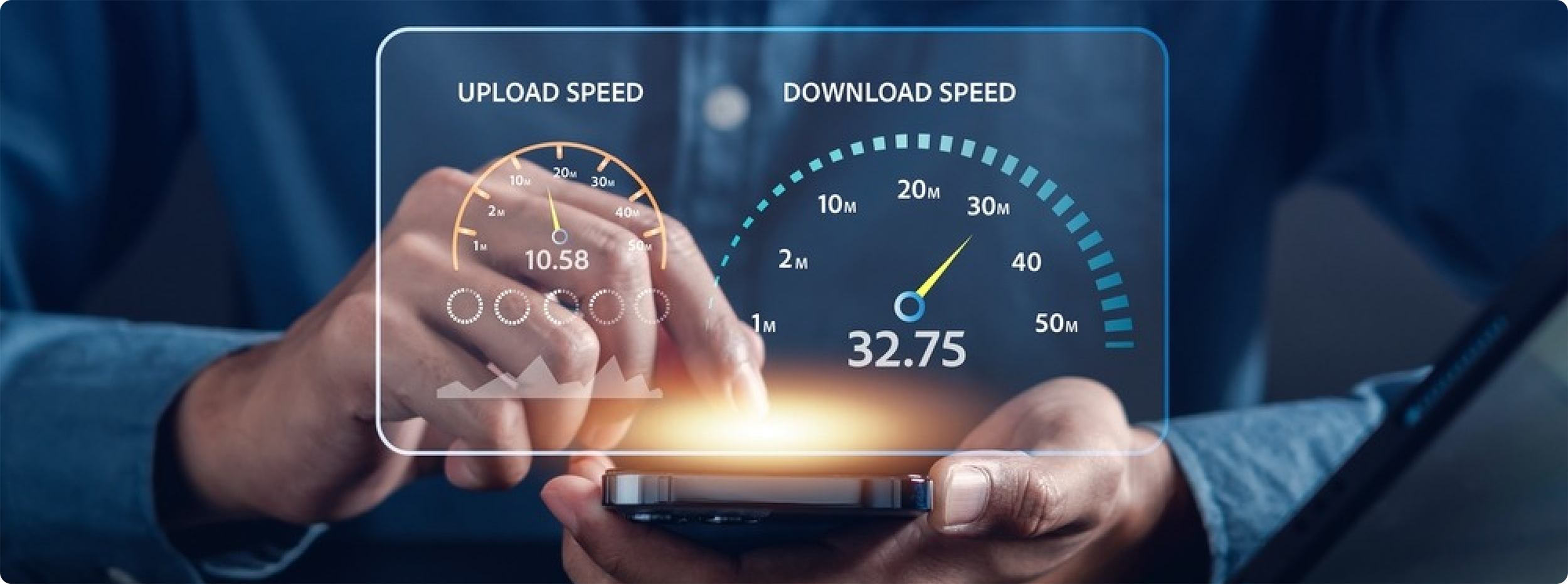Effortless
- Effortless Communication: Reliable Digital
- landline with Crystal Clear Calls and Advanced Features.


Why Symmetrical Upload & Download Speeds Are Important?
When we talk about the fastest internet speeds in my area, the conversation often centres around upload and download speeds. After all, faster download and upload speeds mean on-demand uninterrupted streaming, listening to music, faster website loading for a smooth browsing experience to access online content, going live on social media to connect with followers, making video calls on different apps, and lag-free live gaming. However, what about upload speeds? Why are they important, and why should we look for symmetrical upload and download speeds?
The faster download refers to as how quickly we can browse the internet, on-demand uninterrupted streaming of movies and TV shows, flawless music streaming, etc. whereas, upload bandwidth speeds are typically measured based on how quickly data is transferred from sender to receivers, such as sending emails or files upload on a cloud server. So, it’s important to maintain the far symmetrical or closer to advertised internet speeds.
Many ISP providers promised advertised symmetrical speeds, meanwhile, both advertised and test speeds show asymmetrical connections, which are very common in wireless networks, where download speeds far surpass upload speeds. While this may have sufficed in the past, however, the shift in how we use the internet demands a reevaluation of the importance of symmetrical speeds for robust internet speed without latency and delays.Download speeds have always been higher than upload speeds. But why do download speeds always outweigh over upload speeds? Let’s understand below, and why symmetrical upload and download speeds are important for internet providers.
Most broadband packages pay attention to higher download speeds compared to upload speeds, which is mainly because of our intense engagement in online activities rather than uploading content or files in cloud storage. But that shouldn’t be the norm anymore. Most broadband providers advertise sufficient download speeds, which may be faster than upload speeds, whereas some ISPs throttle your internet bandwidth intentionally without informing you.
But we changed that practice, just get engaged in your effortless online activities, though we’d have symmetrical upload and download speeds because uploading is equally important as downloading.
What is Symmetrical Internet speed?
Let’s understand the concept of a symmetrical internet. In basic terms, bandwidth has equal upload speeds and download speeds, or we better say symmetric data that flows across a wired. This balanced approach to internet connectivity differs from the traditional model, where download speeds were prioritised over upload speeds.
It is primarily in demand for businesses where symmetric upstream and downstream data transmission is in real-time. However, symmetrical internet is gaining popularity among businesses and daily internet users alike. The need for faster and more stable Internet connection for business increases because VoIP phone systems are in demand for better business communication for reliability, office cost optimisations, and low-cost international calls. Similarly, to access the best home internet in your area, you need a significant amount of uploading/downloading speeds from entertainment to better access to online educational content, or for multi-device data use.
But why are internet users in sudden demand for symmetrical speeds?
Historically, our internet activities revolved around downloading data. From browsing websites for better accessibility of online content to streaming flawless music, from multiplayer games to HD quality on-demand videos, the need for high download speeds always had greater precedence. However, times are changing, and uploading data to the cloud, sending emails, and engaging in video conferencing are now integral parts of our online experience.
As asymmetrical internet connections are fit for the typical home internet user, they tend to prioritise download speeds, often they tend to neglect upload speeds as their secondary role. While this setup has suited many users well, now it may no longer be adequate to meet the demands of the evolving symmetric data-hungry users.
A Success Story of Installing Symmetrical Internet Speeds to Rural Yorkshire!
The stunning scenic beauty of rural North Yorkshire is renowned for its impressive architecture, rich cultural heritage, coastal hotspots, buttercup meadows, and Nestled blustery peaks, as travel businesses are very popular there due to the historic ambience. But many faced a common yet significant challenge – unreliable internet connectivity. For years, the team at Inntravel, nestled near Castle Howard, struggled with an internet connection that frequently dropped with a weak Wi-Fi signal, which was a cumbersome task for travellers and hotel businesses for streaming and uploading data.
With sluggish downloads and periodic connection problems leads to uneven playbacks and uploading data was difficult. Staff members could not access the information they needed promptly, which was linked to poor organisational ongoing tasks.
But after they installed Networks extended local Gigabit fibre via high-speed wireless microwave equipment, since then Inntravel has enjoyed a dedicated and symmetrical broadband connection.
Reflecting on the successful installation, as they expressed their satisfaction, said “It was great to be able to find fast, reliable, and symmetric internet on their site”. This real-world success story stemmed from the fact that a symmetrical internet eliminates inconsistencies in communications and boosts customer satisfaction and bottom lines.
The shift from struggling with connectivity issues to enjoying fast and reliable broadband has not only enhanced customer service but also boosted employee engagement and productivity within the organisation.
Similarly, the significance of symmetrical internet speeds extends beyond businesses to individual households in rural UK. Whether you’re sending emails, engaging in video meetings, or involved in online gaming.
So having symmetrical and fastest internet upload/download speeds tailored to your specific needs is really important.
Have symmetrical bandwidth when downloading or uploading files!
For students and enterprise operations, asymmetrical Internet connection could be their big challenge. If they need to upload chunks of images to cloud storage buckets, simultaneously trying to complete academic databases with research PDF files and journals online – that needs a high-speed internet connection. If you have an internet connection with asymmetrical bandwidth, that has much higher data speeds for downloads than for uploads, your system will affect the upload process, there you won’t be able to execute the download process for assignment tasks.
Get a Symmetrical Internet Connection from Zoiko Telecom!
Zoiko Telecom also provides ultrafast broadband connections, our fibre optic broadband for home and private commercial entities in the UK can get the best broadband deals for your local internet needs.
We invite you to explore our services, read testimonials from our happy clients, and talk to our dedicated broadband installer team.
What to do now to get Cheap fibre optic broadband deals UK?
Here’s the deal – when you switch to a new broadband provider, you can take advantage of their attractively priced introductory offers, which can cost you up to 90% less than what you’re currently paying. Yes, that’s right! Switching could potentially save you hundreds of pounds per year.
So, do your research, compare broadband deals, search best internet provider in your area, and haggle for a suitable discount won’t only save money, but you’ll also get the value you need for your home internet.
By following these tips and being mindful of your broadband usage and needs, you can optimise your broadband deal and potentially save money by paying for only what you truly need. Don’t let unnecessary expenses weigh you down for your internet services – make the right decisions and enjoy cost-effective broadband solutions tailored to your preferences.
But, is switching broadband providers a hassle? you may ask. Well, according to a survey, six out of 10 people who recently switched broadband providers found the process to be surprisingly easy.
Still not convinced?
What to Expect?
BT is leading the charge to retire old PSTNs by January 2027, and this means other providers using their network will follow suit. As a telecom service providers, we also follow the similar timescale.
This shift makes it easier for the adoption of Voice over Internet Protocol (VoIP) technology, a key element of the digital phone landscape.
Furthermore, telecom service providers are also working on new technology and network systems – such as changing old copper cables to standard fibre-to-the-cabinet (FTTC) broadband lines.
So, everyone should have access to crystal clear calls, reliable connection, portable, and three-way calling full-fibre digital service (VoIP).
So, new digital phone lines will support telecom communication providers to allow consumers and businesses for crystal-clear phone calls. So, UK telephone networks have access to added new features such as (ACR) Caller ID Blocking services or three-way calling services.
That signifies our traditional landline calling practice would be carried out over digital technology via the internet. That’s called the VoIP phone service, which is also called a “digital phone”.
Digital landline services will use the internet to deliver phone calls and other services. It’s a step towards a more modern and interconnected communication environment.
FAQs: Everything You Need to Know About the Digital Phone Shift?
1. Why a Digital Phone Line?
A digital phone line isn’t just for making calls; it’s about ensuring a seamless connection for all your services through the Internet. With the analogue network shutting down by January 31, 2027, most people in the UK will need to switch to a digital phone line
2. Do I Need to Upgrade to a Digital Phone Line?
Yes, as the existing analogue network will be phased out by 31st January 2027. Most people in the UK will need to switch to a digital phone line before this period.
3. Will My Existing Devices Work?
All devices linked to your current phone line will require compatibility with a router. Your service provider may offer a new router, or you may need additional phone equipment to ensure seamless connectivity.
4. What About Other Services Connected to My Digital Phone Line?
For devices like care alarms, smoke detectors, or security alarms linked to your VoIP or digital phone line, it’s necessary to check if they are compatible with the new digital technology. Reach out to the device/ digital line service provider in the UK or visit the manufacturer’s website for guidance.
5. Are my existing devices connected to digital phone lines?
If you’re worried about existing devices connected to your phone line, don’t worry! Switching to a digital line may require a new router from your service provider to keep everything connected. Some routers even allow you to plug your current analogue phone handset into them directly.
6. What benefits we’re going to get from digital voice services?
Your switch to digital phone lines makes you decent-sounding phone calls, you can able to handle multiple calls or make conference calls, Call Forwarding, and access your landline on the go.
Additionally, its digital landline telephone providers use advanced caller ID authentication technologies or call-blocking tools, so you can be protected from scams and nuisance calls.
So, you’re being moved to digital voice services? Don’t worry, it’s more simple and easy than you might think.
For many, the changeover will be a standardised process. Most phones, especially DECT cordless phones, will continue working without a hitch. The only difference is that you’ll need to plug your phone into your router or a new socket.
So, traditional landlines might need to be changed. Telecom providers will probably offer new VoIP phones and accessories at per cost or you may choose from us, visit here. Some of you might need a new or upgraded router.
Once your digital line set-up is done, your phone will start in operation just like it has. You can keep your existing phone number at work, and similarly, you may enjoy a pleasing dial tone when you lift your handset.
7. Do we need to pay extra rates for digital landlines?
No extra payment perks. Don’t worry about changing how you pay for calls. Even if they’re delivered through your broadband connection, you’ll still pay in the same way as before.
To keep a landline line, you’ll need to shift to a Voice over Internet Protocol (VoIP) service. These changes are already ongoing, but you don’t need to take any immediate action. Your telecom provider will reach out to you when your service is ready to be changed.
However, if you’re eager to explore VoIP services now, you can upgrade to a new phone and broadband package.
If you need access to Ultrafast Full Fibre broadband service, don’t worry, Visit us now. Also, you can still add a digital phone line to your existing broadband service.
Check Compatibility!
Some digital landline service providers in the UK may require you to purchase additional equipment or upgrade existing devices connected to your phone line. It’s a good idea to check with your provider to ensure everything is compatible with the digital phone line.
Where to Get Digital Landline Set Up?
If you choose an Ultrafast Full Fibre broadband device and accessories, a digital phone line will be automatically included when you take a phone service.
Keep an eye out for updates on Zoiko Telecom’s digital landline service as we roll out Ultrafast Full Fibre broadband plans and VoIP phone service to homes and businesses already.
Don’t worry about the switch to digital voice services. It’s a step towards a better and more interconnected future on-the-go service, ensuring that your phone service remains reliable and efficient.




